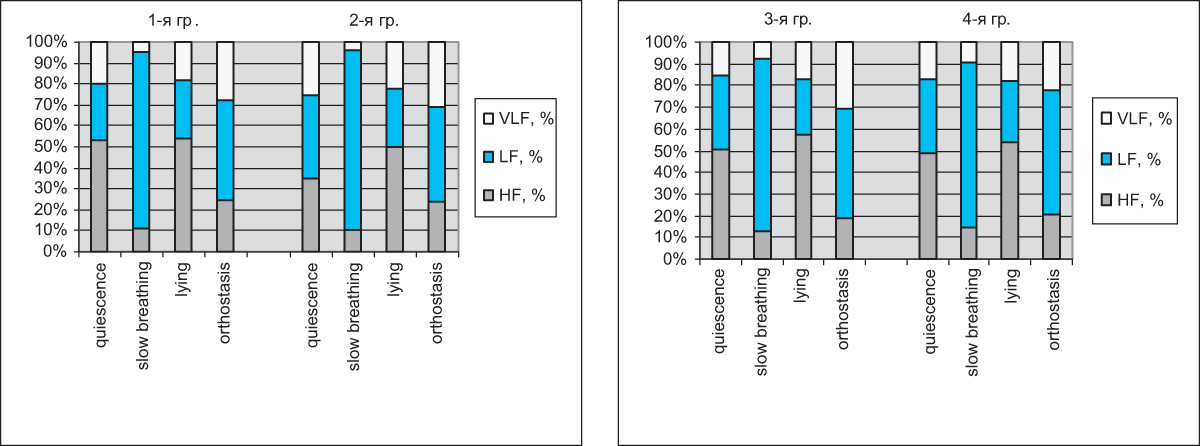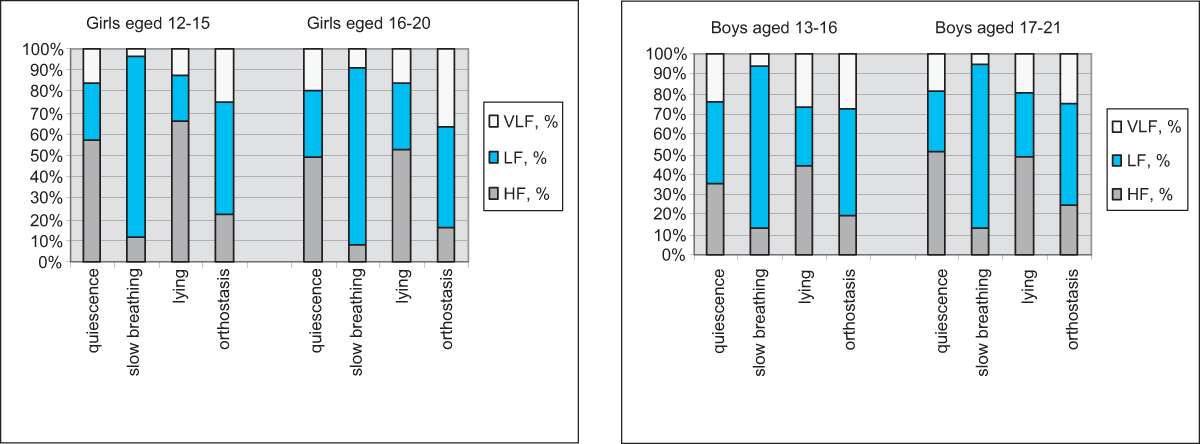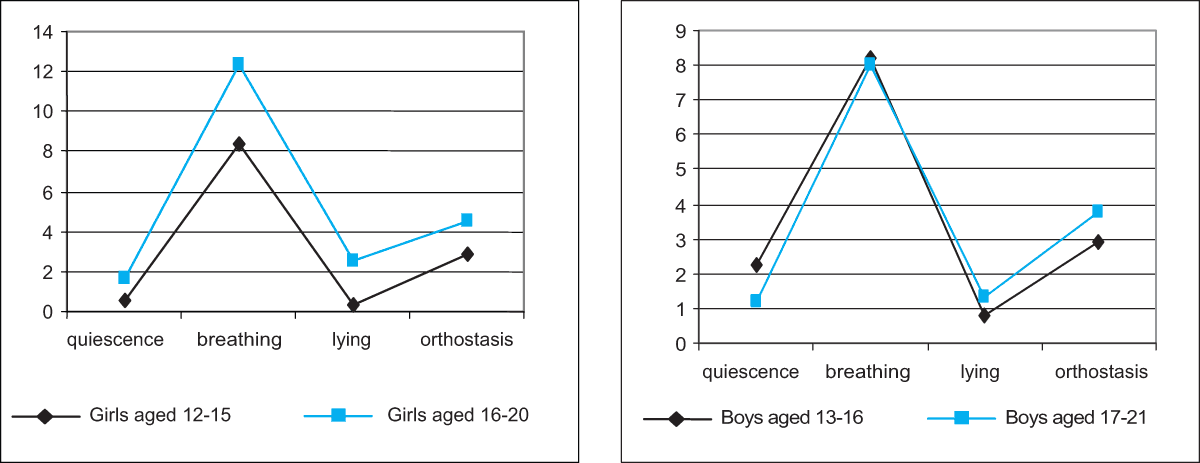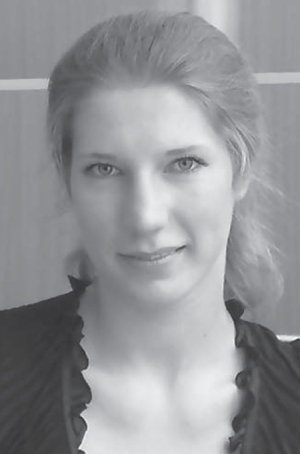SPECIFICS OF HEART RATE INDICATORS OF ATHLETES WITH VARIOUS SPORTS PERFORMANCE
Фотографии:
ˑ:
T.S. Ivanova, postgraduate student
N.N. Zakhar’eva, professor, Dr.Med.
Russian state university of physical culture, sport and tourism (SCOLIPC), Moscow
Introduction. Heart rate variability indices are widely used in physiology [1]. [2], but nowadays they acquire even more value while allocating predictive markers of sports performance. The lack of reproduction of sports results in competitions due to developing unfavorable pre-starting conditions in athletes is an acute problem of modern athletics. Nowadays such changes are diagnosed by means of spectroscopic analysis of heart rate, promoting assessment of regulatory systems in competitive conditions [3,7,9]. The search for predictive criteria of rate changes will promote allocation of the types of vegetative regulation of athletes with varied adaptive features and consequently different results.
Materials and methods. 48 athletes aged 12-21 specialized in sprint and middle-distance run, with the sports qualifications from the 3rd senior degree to masters of sports, regulars in competitions, were subjected to examination. The groups of athletes of certain ages were allocated in compliance with the age periodization in view of functional, biochemical morphological and mental body properties (A.S. Solodkov, E.B. Sologub, 2005, V.D. Son’kin, 2008):
- Teen age: the age of 12-15 (10 girls) and 13-16 (8 boys)
- Junior: the age of 16-20 (12 girls) and 17-21 (18 boys).
Herewith, the competitive results were analyzed to reveal athletes improving their results in competitions (group 1), reproducing their result (group 2), showing unstable result (group 3) and deteriorating their result (group 4).
The study of heart rate indices was carried out in the preliminary period of the year training cycle using a spiroarteriocardiorhythmograph (SACR) (“Itox”, St.Petersburg) including the following functional tests: quiescent seating, paced breathing test (6 cycles/min), and clinoorthostatic test, with records lying and standing (active orthostasis).
Whilst analyzing the functional tests we considered total spectrum power, VLF, LF and HF waves range and LF/HF vegetative balance index.
Results and discussion. Proceeding from the research results, athletes of various ages and sexes differ in heart rate variability indicators. The mean values of total spectrum power by heart rate in teen-age and junior girls (3615,6 ms2 and 3814,9 ms2 respectively) are lower than in teen-age and younger boys (5647,6 ms2 and 6751,3 ms2 respectively).
Moreover, sexual dimorphism was revealed in the spectrum components of heart rate. Thus at quiescence the 12-15-aged girls showed the dominating high frequency waves. The mean HF share was 57,3%, whereas the level of LF waves was only 26,7%, and 16% for VLF. On the contrary, for teenaged boys (aged 13-16) 40,6% belong to low frequency waves (LF), 35,4% to high frequency waves (HF) and 24% to very low frequency (VLF) waves. Junior girls still have high frequency waves as dominating, which share slightly decreases to 48,9%, causing a small increase of low and very low frequency waves: LF – 31,2%, VLF – 19,9%. In boys aged 17-21 the change in the situation to domination of high frequency waves is observed, its participation in the total spectrum is already 51,1%. Herewith, the share of LF and VLF waves drops: 30,4% and 18,5% correspondingly. Therefore, sexual dimorphism and age dynamics of spectrum heart rate indices and its power are revealed in the quoted subjects.
Whilst considering groups of athletes with various sports performance the heart rate indicators distribute as follows. The least values in the total range of heart rate belong to the group 3 (mean value of 3853,5 ms2), the index of the 2nd group of athletes equals to 4479,6 ms2, and the highest values are in group 1 and 4 with 5791,7 ms2 and 6620,2 ms2 correspondingly.
The trend of the distribution of spectrum indicators at quiescence is practically identical in the allocated groups, except for the group 2 with the per cent of LF-frequencies exceeding the one of HF (40% versus 39,4%) and the highest per cent of VLF waves of 25,1%. In other groups the HF-component is dominating with the highest value in the group 1 (52,8%). This group is also characterized by the lowest participation of LF – 27% and 20,2% for VLF waves. The indices of the groups 3 and 4 are almost the same, but their share of low frequency waves is higher than in the group 1, proving that athletes, improving their result, have less tension in functional systems at quiescence (fig. 1).

Fig. 1. Dynamics of the structure of the heart rate spectrum within varied functional tests in athletes with various sports performance.
The analysis of the spectrum characteristics in the athletes from the allocated groups has shown various levels of reactivity of heart rate components to functional tests. While comparing quiescence and slow breathing indices the group 1 was proved to have the most notable changes in the HF and LF range. The HF index decreases to 41,7%, and the LF index – to 57%, at slight decrease of the share of very low frequency waves (-15,3%). The group 2 showed serious decrease of VLF waves – by 21,14%. The least HF changes were observed in the group of athletes № 2 – 24,4%, and LF – in the group 4 -42%.
It is to be marked that changes in the quoted indicators at clinoorthostatic test were positive. The groups 3 and 4 of athletes had the highest reactivity of heart unit indicators. While standing up the changes in the range of high frequency waves reached in the groups 3 and 4 - 38,2% and - 33,1%, and low frequency ones - 25% and 29,5% correspondingly. As for very low frequency waves, the priority in their changes belonged also to the group 3, whereas the least changes were in the group 4.
As seen in our researches sex and age determine the variety in changes of the abovementioned indices. The strongest response to the slow breathing test and orthostasis is marked in 12-15-aged girls. While changing to slow breathing their number of high frequency waves decreased by 45,6% and the number of low frequency ones – increased by 57,7%. According to the results of clinoorthostatic test girls of the same age had essential changes: the per cent of low frequency waves decreased by 43,7%, and high frequency ones – by 31,6%. Boys had minor rearrangements of the frequency range within the quoted tests (Fig.2).

Fig. 2. Dynamics of the structure of the spectrum of cardiac rate within varied functional tests in athletes on various age stages.
The dynamics of the LF/HF vegetative balance within functional tests is interesting to trace. According to Fig. 3, the girls aged 16-20 show higher indices of vegetative balance than the ones aged 12-15 during each of the subjected tests with the most essential variety seen in the slow breathing test.

Fig. 3. The features of vegetative balance changes in girls and boys on various age stages within functional tests with breathing 6 cycles/min and clinoorthostatic test.
However, it is different with the boys. Their vegetative balance indicators are the same at the slow breathing test, but have an opposite trend at quiescence and at clinoorthostatic test.
The consensus representatives of vegetative balance at quiescence can be characterized as a manifestation of normotonic reaction in girls in both of the age periods (Table) and sympathetic reaction in boys also in both of the age periods. Herewith, as opposed to boys girls are more “similar” to each other by the level of values: the range does not exceed 1,48. As anticipated, in the functional slow breathing test all athletes show sympathetic reaction. However, this index in the lying position indicated not only to the athletes’ normotonic reaction, but also to vagotonia in the girls aged 12-15. It is to be marked, that in this test the range of values increases with the age. The orthostatic reaction provokes the intensified sympathetic effects in all testees, where the highest values of vegetative balance belong to the girls aged 16-20 and boys aged 17-21, the range also grows with the age.
Table. Vegetative balance indicators at functional tests: quiescence, breathing 6 cycles/min, lying, orthostasis (R – range).
|
|
Quiescence |
Bradypnea |
Lying |
Orthostasis |
||||
|
M±σ |
R |
M±σ |
R |
M±σ |
R |
M±σ |
R |
|
|
Girls aged 12-15 |
0,58±0,52 |
1,48 |
8,36±3,12 |
7,77 |
0,37±0,24 |
0,55 |
2,85±1,72 |
5,31 |
|
Girls aged 16-20 |
0,78±0,53 |
1,55 |
12,76±5,57 |
14,8 |
0,94±1,75 |
5,81 |
3,54±3,56 |
12,37 |
|
Boys aged 13-16 |
2,26±2,21 |
6,09 |
8,19±3,48 |
11,81 |
0,77±0,44 |
1,37 |
2,88±0,83 |
2,41 |
|
Boys aged 17-21 |
1,19±1,66 |
6,36 |
8,01±5,37 |
17,82 |
1,34±1,85 |
6,4 |
3,79±4,1 |
15,11 |
|
Group 1 |
0,99±1,48 |
6,28 |
9,44±5,21 |
17,4 |
1,08±1,64 |
6,4 |
3,17±3,2 |
15,11 |
|
Group 2 |
2,81±2,91 |
6,1 |
9,62±4,74 |
12,71 |
0,61±0,33 |
0,74 |
2,69±2,29 |
5,17 |
|
Group 3 |
0,83±0,55 |
1,55 |
8,5±4,28 |
15,6 |
0,56±0,42 |
1,37 |
3,34±2,58 |
9,66 |
|
Group 4 |
0,93±0,77 |
1,89 |
7,57±4,35 |
6,57 |
1,44±2,49 |
5,81 |
4,6±4,91 |
11,78 |
The distribution of athletes into groups by efficiency has shown the normotonic type of reaction at quiescence in all groups but the group 2 with sympathicotonia. Herewith, in the groups 1 and 2 the range is up to 6,28 and 6,1, whereas in other groups it is under 1,89.
The highest values of vegetative balance (9,44 и 9,62) are observed in the slow breathing test in the groups 1 and 2 (athletes improving and reproducing their result). Besides the group 1 has the most expressed changes compared to the state of quiescence: the index changes by 8,45. The least marked sympathetic indicator of 7,57 and the lowest reactivity (change in the balance index between quiescence and slow breathing) of 6,64 are shown in the group 4.
In all the groups athletes show normotonic reaction while lying and sympathetic one when standing up. However, athletes of the group 4 (not reproducing the result) show the ultimate result in vegetative balance and reactivity compared to other groups: their index changes by 3,16 while standing up. Here the lowest reactivity is observed in the groups 1 and 2, their indicators change by 2,09 and 2,08 correspondingly.
Conclusions:
1) Sex and age dimorphism has been allocated in the heart rate indicators of teen-age and junior athletes. The boys’ indices of the general power of the spectrum of heart rate exceed the ones for girls. Boys have a trend to dominating high frequency waves, whereas for girls some decrease of the HF range is specific. The strongest reaction to the slow breathing test and orthostasis was marked in the girls aged 12-15. Boys had less significant changes in the frequency range within the given tests.
2) The athletes improving and reproducing their result show the most marked changes in the frequency range in the slow breathing test and the lowest reactivity in the clinoorthostatic test.
3) The athletes with unstable and deteriorating results show the most essential changes in the studied indicators in the clinoorthostatic test and the slightest changes in the slow breathing test compared to quiescence.
References
- Baevsky, R.M. The concept of physiological norm and health criteria // Ros. Fiziol. Zhurn. im. I.M. Sechenova. – 2003. – V. 89. - № 4. – P. 473-487. (In Russian)
- Baevsky, R.M. Heart rate variability: theoretical aspects and capacities of clinical use / R.M. Baevsky, G.G. Ivanov // Ultrazvukovaya i funktsional’naya diagnostika. – 2001. - № 3. – P. 108-127. (In Russian)
- Ivanova, T.S. The effect of vegetative indices on athletes’ sports performance // Proceedings of the All-Rus. scient.-pract. conference “Physical culture and student sport: problems of realization of the strategy of development”. – Kazan, 2012 – P.351-353. (In Russian)
- Kuznetsova, O.V. Autonomic regulation of respiratory-hemodynamic system in children aged 8-11 with various baroreflex sensitivity / O.V. Kuznetsova, V.D. Son’kin // Fiziologiya cheloveka. – 2008. – V. 34. - № 5. – P. 106-116. (In Russian)
- Kuznetsova, O.V. Spectroscopic analysis of heart rate variability, arterial pressure and breathing in children aged 8-11 at quiescence / O.V. Kuznetsova, V.D. Son’kin // Fiziologiya cheloveka. – 2005. - V 31. - № 1. – P. 33-39. (In Russian)
- Pankova, N.B. Methods problems of rapid assessment of the functional status of cardiovascular system / N.B. Pankova, M.Yu. Karganov, A.G. Fesenko // Vestnik vosstanoviyel’noy meditsiny. – 2011. - № 6 (46). – P. 60-63. (In Russian)
- Pankova, N.B. The effect of correction of elementary status on the dynamics of functional status of female rugby player body in the competitive period (based on the results of polysystemic monitoring) / N.B. Pankova, E.N. Arkhipova, A.G. Fesenko. I.B. Alchinova, M.Yu. Karganov // Vestnik vosstanoviyel’noy meditsiny. – 2011. - № 5 (45). – P. 60-66. (In Russian)
- Sapozhnikova, E.N. Age and individual features of heart rate variability in children aged 7 to 12 at quiescence and at orthostatic test / E.N. Sapozhnikova, N.I. Shlyk // Methodological support of physical education, sports training and recreational gymnastics. – 2002. – P. 147-153. (In Russian)
- Shlyk, N.I. Heart rate and type of vegetative regulation in female athletes in middle-distance run within training process / Fizkultura v profilaktike, lechenii i reabilitatsii. – 2010. -№ 3-4. –P. 17-23. (In Russian)
- Shlyk, N.I. Specifics of orthostatic reaction in athletes with various dominating types of vegetative regulation by the data of the analysis of heart rate variability // Fizkultura v profilaktike, lechenii i reabilitatsii. – 2011. -№ 1-2. – P. 13-25. (In Russian)
Author’s contacts: Devchonochka8@yandex.ru



 Журнал "THEORY AND PRACTICE
Журнал "THEORY AND PRACTICE